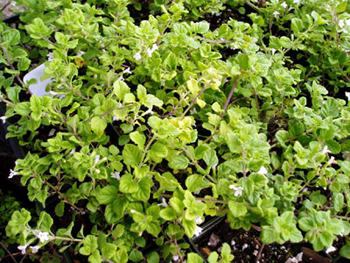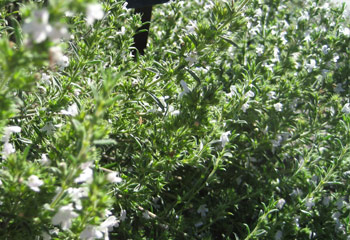Contents:
Common Names | Parts Usually Used | Plant(s) & Culture | Where Found | Medicinal Properties | Biochemical Information
Legends, Myths and Stories | Uses | Formulas or Dosages | Bibliography
Scientific Names

- Satureja hortensis L.
- Satureja montana L.
- Labiatae
- Mint family
Common Names
Satureja hortensis:
- Bean herb
- Summer savory
Satureja montana:
- Winter savory
Parts Usually Used
Satureja hortensis:
The whole plant
Satureja montana:
The whole plant
Back to Top
Description of Plant(s) and Culture

Satureja hortensis:
Summer savory is an annual plant; the branching root produces a bushy, hairy stem which grows from 1 to 1 1/2 feet high, often taking on a purple hue as it matures. The opposite, small, oblong-linear leaves are sessile or nearly so, gray-green or bronze-green, on many-branched stems and may have hairy margins. The small pink or white, two-lipped flowers grow in whorl-like cymes from July to October. The entire plant is strongly aromatic.
Satureja montana:
Winter savory is an evergreen perennial species, 12-16 inches high, more woody and bristly than summer savory. It branches profusely from the ground up and produces lanceolate, pointed leaves on more or less hairy stems. Lilac to white flowers are borne in the leaf axils. It has the same medicinal properties as summer savory but the leaves are stiffer than summer savory, and more aromatic, with a stronger peppery thyme flavor. They can both be harvested fresh all year.
Other varieties:
Calamint (S. arkansana) is a creeping perennial 4-8 inches high; leaves are oval at the base of the plant; the stem leaves are linear with oil glands on them. Leaves are strongly pennyroyal-scented. The flowers, 3/8 inch long, are purplish, two-lipped and bloom in April to July. Found in rocky glades from western New York to Arkansas, Texas; north to Illinois and Indiana. Used as a substitute for American Pennyroyal (Hedeoma pulegioides).
Jamaican Mint Bush (S. viminea) is a woody shrub that grows up to 6 feet tall. Mint bushes are popular in Jamaica for teas and to relieve indigestion.
Back to Top
Where Found
Satureja hortensis and Satureja montana:
Grows wild in the Mediterranean area and is widely cultivated elsewhere as a kitchen herb.
Back to Top
Medicinal Properties
Satureja hortensis:
Antispasmodic, aphrodisiac, astringent, carminative, condiment, diaphoretic, emmenagogue, expectorant, stimulant, stomachic
Back to Top
Biochemical Information
Satureja hortensis:
Essential oil including 30% carvacrol and 20% cymol
Back to Top
Legends, Myths and Stories
Both Winter and Summer savory have a pleasant, piquant flavor, though winter savory is stronger and more resinous. Used similarly, both are best known for their use with vegetables and all types of beans. Known as “bean herb” in Germany, the savories not only give flavor but cut down on the gas produced by beans. They also eliminate the strong odors in cabbage and turnips if you put 2 to 3 leaves in the cooking water. Best used fresh; must be home grown.
Summer savory probably originated in the regions around the Black Sea and the eastern Mediterranean. Benedictine monks brought it, along with many other potherbs, across the Alps to Europe, and Charlemagne, in his Capitulary on the management of his landed estates, ensured that it found its way into the gardens of monasteries and peasants’ farms.
In the Middle Ages, Summer savory grew in every monastery garden and still today it is prized as a kitchen herb. It was used for seasoning and as a remedy, and Abbess Hildegard of Bingen, Germany, a reputable medieval herbalist and recognized as such even in modern times, recommended savory as a valuable herb. The leaves are used in seasoning, sometimes combined with sage.
Anyone suffering from low blood pressure (Hypotension) would do well to use savory in addition to hyssop in the preparation of food. This herb was also highly valued in the Middle Ages because it was thought to stimulate the gonads.
Summer savory was known to the Romans, who used its hot, pepperlike flavor to season dishes before other spices were widely used.
Back to Top
Uses
Satureja hortensis:
The tea is a safe remedy for most stomach and intestinal disorders, including cramps, nausea, diarrhea, gargle for sore throats, colds, asthma, suppressed menses, flatulence, colic, chest congestion, and lack of appetite. Savory is said to have aphrodisiac properties. The oil dropped onto a tooth will relieve a toothache. The juice heated with oil of Roses, and dropped into the ears, eases them of the noise and singing in them, and of deafness also (so Culpeper claims).
Externally, a poultice of savory and wheat flour eases sciatica, and palsy, heating and warming them, and takes away the pain. This poultice also takes away the stinging of bees, wasps, etc.
The uses of savory are similar to those of oregano and marjoram. Known to the German as Bohnenkraut, beans and savory.
Satureja montana:
Winter savory has the same medicinal properties as summer savory.
Back to Top
Formulas or Dosages
Satureja hortensis:
Infusion: steep 2 to 4 tsp. dried herb in 1 cup boiling water. Take 1 cup per day, a mouthful at a time.
Back to Top
Bibliography
![]() Back to Eden
Back to Eden, by Jethro Kloss; Back to Eden Publishing Co., Loma Linda, CA 92354, Original copyright 1939, revised edition 1994
![]() Country Home Book of Herbs
Country Home Book of Herbs, Meredith Books, Editorial Dept. RW240, 1716 Locust Street, Des Moines, IA 50309-3023, copyright 1994
![]() Culpeper’s Complete Herbal & English Physician: Updated With 117 Modern Herbs
Culpeper’s Complete Herbal & English Physician: Updated With 117 Modern Herbs, by Nicholas Culpeper, Meyerbooks, publisher, PO Box 427, Glenwood, Illinois 60425, 1990, (reprint of 1814)
![]() Eastern/Central Medicinal Plants
Eastern/Central Medicinal Plants, by Steven Foster and James A. Duke., Houghton Mifflin Company, 215 Park Avenue South, New York, NY 10000
 The Healing Plants
The Healing Plants, by Mannfried Pahlow, Barron’s Educational Series, Inc. 250 Wireless Blvd., Hauppauge, NY 11788, 1992
![]() The Herbalist Almanac
The Herbalist Almanac, by Clarence Meyer, Meyerbooks, publisher, PO Box 427, Glenwood, Illinois 60425, copyright 1988, fifth printing, 1994
![]() The Herb Book
The Herb Book, by John Lust, Bantam Books, 666 Fifth Avenue, New York, NY. copyright 1974.
Herbal Gardening, compiled by The Robison York State Herb Garden, Cornell Plantations, Matthaei Botanical Gardens of the University of Michigan, University of California Botanical Garden, Berkeley., Pantheon Books, Knopf Publishing Group, New York, 1994, first edition
![]() The Nature Doctor: A Manual of Traditional and Complementary Medicine
The Nature Doctor: A Manual of Traditional and Complementary Medicine, by Dr. H.C.A. Vogel; Keats Publishing, Inc., 27 Pine Street (Box 876) New Canaan, CT. 06840-0876. Copyright Verlag A. Vogel, Teufen (AR) Switzerland 1952, 1991
![]() Planetary Herbology
Planetary Herbology, by Michael Tierra, C.A., N.D., O.M.D., Lotus Press, PO Box 325, Twin Lakes. WI 53181., Copyright 1988, published 1992
![]() Webster’s New World Dictionary
Webster’s New World Dictionary, Third College Edition, Victoria Neufeldt, Editor in Chief, New World Dictionaries: A Division of Simon & Schuster, Inc., 15 Columbus Circle, New York, NY 10023
![]() The Yoga of Herbs: An Ayurvedic Guide to Herbal Medicine
The Yoga of Herbs: An Ayurvedic Guide to Herbal Medicine, by Dr. David Frawley & Dr. Vasant Lad, Lotus Press, Twin Lakes, Wisconsin, Second edition, 1988.
 The Rodale Herb Book: How to Use, Grow, and Buy Nature’s Miracle Plants (An Organic gardening and farming book)
The Rodale Herb Book: How to Use, Grow, and Buy Nature’s Miracle Plants (An Organic gardening and farming book), edited by William H. Hylton, Rodale Press, Inc. Emmaus, PA, 18049., 1974
